

Scheyern Abbey, formerly also Scheyern Priory (German : Kloster Scheyern), is a house of the Benedictine Order in Scheyern in Bavaria.


Scheyern Abbey, formerly also Scheyern Priory (German : Kloster Scheyern), is a house of the Benedictine Order in Scheyern in Bavaria.

The monastery at Scheyern was established in 1119 as the final site of the community founded in around 1077 at Bayrischzell by Countess Haziga of Aragon, wife of Otto II, Count of Scheyern, the ancestors of the Wittelsbachs. The first monks were from Hirsau Abbey, of which the new monastery was a priory, founded as it was against the background of the Investiture Controversy and the Hirsau Reforms. The original site proved unsuitable for a number of reasons, including difficulties with water supply, and the monastery moved in 1087 to Fischbachau. When that site too proved unsuitable, they moved to Petersberg, in 1104.
When Haziga, the widowed Countess of Scheyern, left Burg Scheyern in 1119 for Burg Wittelsbach, the castle from which the family subsequently took their name, the old castle, constructed in about 940, was given to the monks at Petersberg and became Scheyern Abbey, independent of Hirsau.
Scheyern was considered a Wittelsbach family monastery, which they used as a place of burial until 1253. The Wittelsbachs also retained the office of Vogt .
The dedication is to the Holy Cross and the Assumption of the Virgin Mary: the abbey has had in its possession since 1180 a relic of the True Cross from Jerusalem, and is still today a place of pilgrimage for this reason.
By the 13th century the abbey had already gained a reputation for its school of illumination and its scriptorium.
It suffered particularly severely in the Thirty Years' War and did not participate afterwards in the Baroque revival to the same extent as other monasteries in Bavaria. In the 18th century however it was refurbished in the style of the Rococo.
On 15 November 1802 the monastery came under the governance of the territorial rulers, and on 21 March 1803 was dissolved as part of the secularisation of Bavaria. The buildings were sold, and changed hands several times in a short period.

In 1838 however under Ludwig I of Bavaria the monastery was re-established, and re-settled by monks from Metten Abbey; in 1843 it regained the status of an abbey. Between 1876 and 1878 the church, now serving both the community and the parish, was restored to the Romanesque style.
Scheyern now also possesses a Byzantine Institute, specialising in the works of Saint John of Damascus. It also enjoys historical links with Hungary.
Scheyern Abbey is a member of the Bavarian Congregation of the Benedictine Confederation.
Shortly after the re-establishment in 1838, a grammar school was opened. In 1939 all schools run by religious orders were closed, including Scheyern Abbey's. After World War II a humanistic Gymnasium was opened here. It was replaced however in 1970 by the Schyrengymnasium in Pfaffenhofen. Once the transfer to the new school was complete, the monastery set up a residential high school for vocational training, the Staatliche Berufsoberschule, a type of school which was considered very experimental at the time. It opened in 1976 and is still in operation.
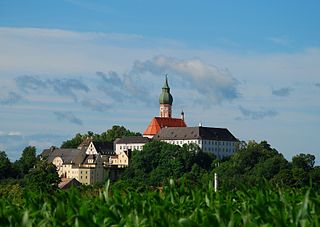
The Benedictine priory and erstwhile abbey of Andechs is a place of pilgrimage on a hill east of the Ammersee in the Landkreis of Starnberg in Germany, in the municipality Andechs. Andechs Abbey is famed for its flamboyant Baroque church and its brewery, Klosterbrauerei Andechs. Composer Carl Orff is buried in the church.

Ettal Abbey is a Benedictine monastery in the village of Ettal close to Oberammergau and Garmisch-Partenkirchen in Bavaria, Germany. With a community of more than 50 monks, with another five at Wechselburg, the Abbey is one of the largest Benedictine houses and is a major attraction for visitors.
Aura Abbey was a house of the Benedictine Order located at Aura an der Saale in Bavaria in the Diocese of Würzburg.
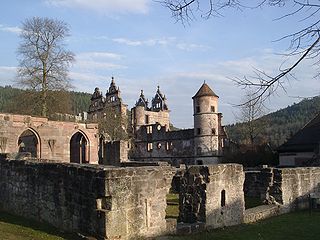
Hirsau Abbey, formerly known as Hirschau Abbey, was once one of the most important Benedictine abbeys of Germany. It is located in the Hirsau borough of Calw on the northern slopes of the Black Forest mountain range, in the present-day state of Baden-Württemberg. In the 11th and 12th century, the monastery was a centre of the Cluniac Reforms, implemented as "Hirsau Reforms" in the German lands. The complex was devastated during the War of the Palatine Succession in 1692 and not rebuilt.

Reichenbach Monastery or Priory was a house of the Benedictine Order, located at Klosterreichenbach, now part of Baiersbronn in Baden-Württemberg in Germany.

Schönrain Priory was a house of the Benedictine Order located near Lohr in the Spessart, in Bavaria in southern Germany. Few signs of the monastic buildings are visible today. The ruins that remain mostly consist of later additions when the structure served as a temporal dwelling and foresters' lodge.
Fischbachau Priory was a Benedictine monastery located in Fischbachau, Bavaria, Germany.

Tegernsee Abbey is a former Benedictine monastery in the town and district of Tegernsee in Bavaria. Both the abbey and the town that grew up around it, are named after the Tegernsee, the lake on the shores of which they are located. The name is from the Old High German tegarin seo, meaning great lake.

Niederaltaich Abbey is a house of the Benedictine Order founded in 741, situated in the village of Niederalteich on the Danube in Bavaria.
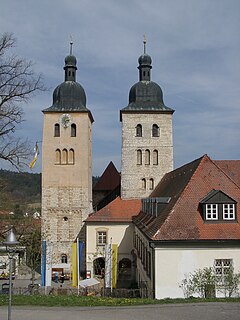
Plankstetten Abbey is a monastery of the Benedictines located between Berching and Beilngries in Bavaria, Germany. It is a member of the Bavarian Congregation of the Benedictine Confederation.

Prüfening Abbey was a Benedictine monastery on the outskirts of Regensburg in Bavaria, Germany. Since the beginning of the 19th century it has also been known as Prüfening Castle. Notably, its extant dedicatory inscription, commemorating the founding of the abbey in 1119, was created by printing and is a unique document of medieval typography.
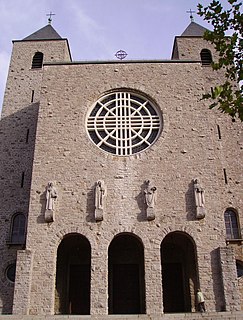
Münsterschwarzach Abbey, is a Benedictine monastery in Germany. It is located at the confluence of the rivers Schwarzach and Main in Bavaria.
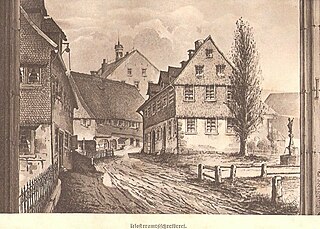
St. George's Abbey in the Black Forest was a Benedictine monastery in St. Georgen im Schwarzwald in the southern Black Forest in Baden-Württemberg, Germany.

Fürstenfeld Abbey is a former Cistercian monastery in Fürstenfeldbruck in Bavaria, Germany.

Otto V, Count of Wittelsbach, also called Otto IV, Count of Scheyern, was the second son of Eckhard I, Count of Scheyern. Otto named himself Otto of Wittelsbach, after Wittelsbach Castle near Aichach. He served Henry V, Holy Roman Emperor, in his first Italian Expedition in 1110–1111. Emperor Henry V already addressed him as Otto Count of "Witlinesbac" in a document in 1115. From 1120 onwards, he was Count palatine of Bavaria.

Wittelsbach Castle was a castle near Aichach in today's Bavarian Swabia.
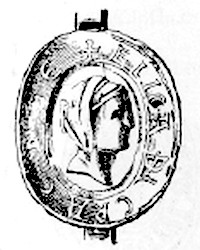
Heilika of Pettendorf-Lengenfeld was by marriage Countess Palatine of Bavaria.
Haziga of Diessen, also known as Hadegunde was a Countess consort of Scheyern. Her descent is not entirely clear. It is usually assumed that her father was Count Frederick II of Diessen. He was Vogt of the Cathedral chapter in Regensburg. He was married three times; it is unclear in which marriage Haziga was born.
Otto VIII, Count of Bavaria was Count Palatine of Bavaria from 1189 to 1209.